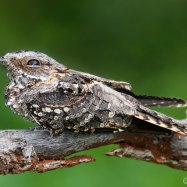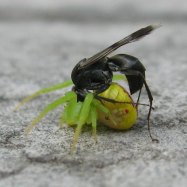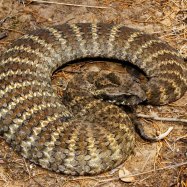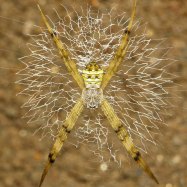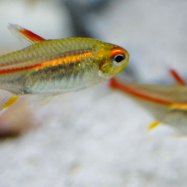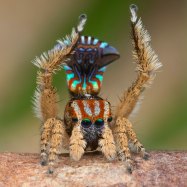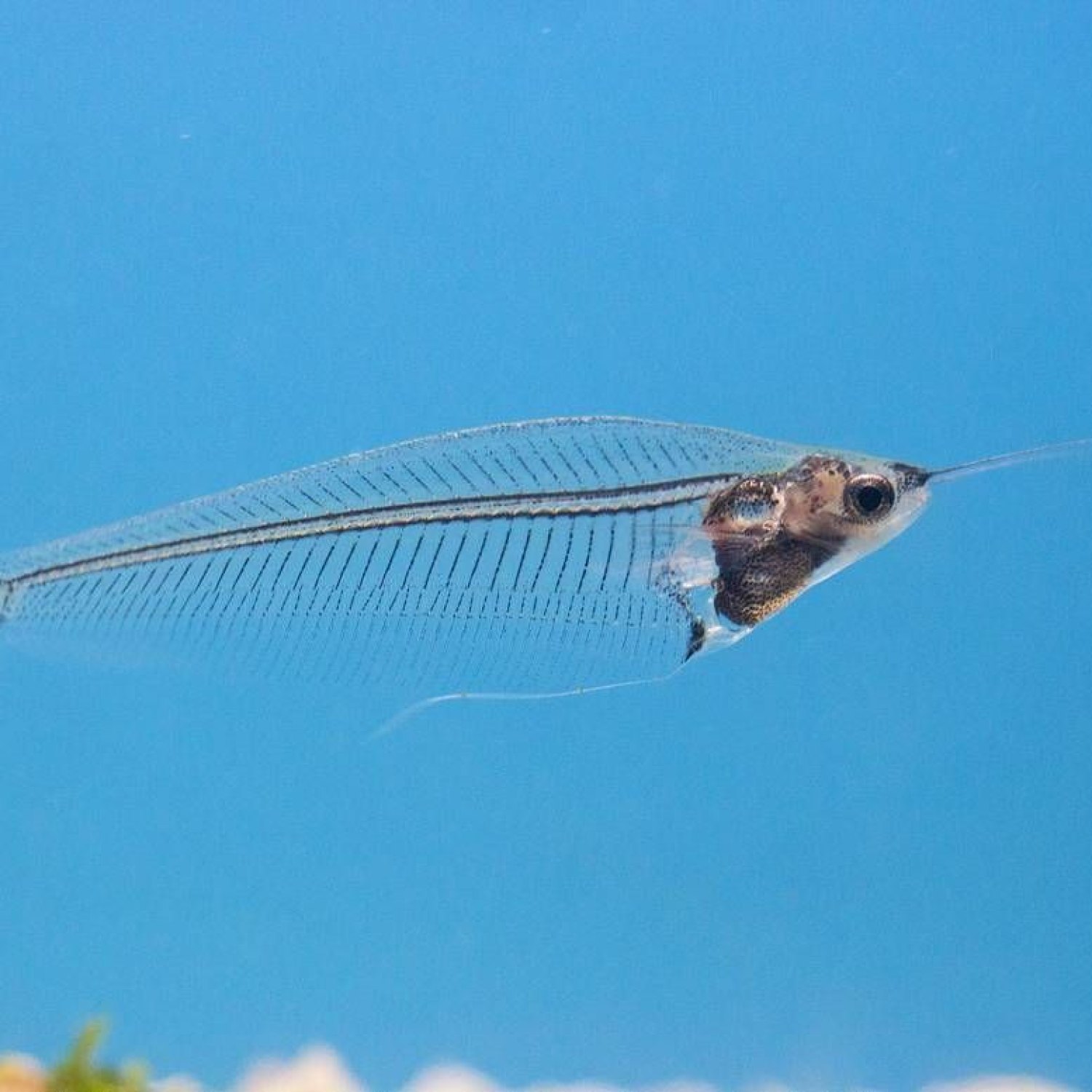
Ghost Catfish
Up to 4 inches
The Ghost Catfish, also known as Glass Catfish, is a popular choice for freshwater aquariums. This unique fish can grow up to 4 inches and has an elongated, slender body. As part of the Siluridae family, they are peaceful and easy to care for. Their transparent appearance adds an eerie element to any tank. #GhostCatfish #AquariumFish #FreshwaterFish
Animal Details Summary:
Common Name: Ghost Catfish
Kingdom: Animalia
Habitat: Rivers and streams
The Mystical Ghost Catfish: A Closer Look at the Invisible Creature
In the vast and mysterious depths of Southeast Asian rivers and streams, lives a creature that has captured the curiosity and fascination of many. Its translucent appearance and elusive nature have earned it the aptly given name - Ghost Catfish. Scientifically known as Kryptopterus vitreolus, this unique species belongs to the Kingdom Animalia, Phylum Chordata, and Class Actinopterygii. They are part of the Siluriformes order and Siluridae family, making them distant relatives of other catfish such as Pimelodidae and Doradidae Ghost Catfish.The Ghost Catfish is native to Thailand, and its geographical distribution is limited to Southeast Asia. Despite its limited range, this species' popularity has crossed borders, mainly due to its distinctive characteristics. In this article, we will delve deeper into the world of the Ghost Catfish, uncovering its mysterious nature, habitat, feeding habits, and unique features.
A Transparent Wonder: The Ghost Catfish's Appearance
As the name suggests, the Ghost Catfish has a ghostly appearance, making them almost invisible to the naked eye. Their body color ranges from a clear, transparent, to a slightly more opaque, translucent shade. This feature is a result of a lack of pigmentation in their skin, which allows us to see right through them. It is fascinating to see their internal organs, bones, and even undigested food through their skin.However, don't be fooled by their transparent appearance; this species is still a fully functional and robust predator. Their body shape is elongated and slender, enabling them to maneuver effortlessly in the water German Shorthaired Pointer. They have two pairs of barbels (whisker-like sensory organs) near their mouth, which helps them navigate in their surroundings.
The Ghost Catfish can grow up to 4 inches in length, making them relatively small in comparison to other catfish species. But what they lack in size, they make up for in their unique physical appearance, making them sought-after additions to aquariums.
Where Can You Find the Ghost Catfish?
If you are planning to embark on a journey to find the Ghost Catfish in its natural habitat, then head to the rivers and streams of Southeast Asia. Their preferred freshwater habitats are usually found in the lower reaches of rivers, where the current is slower. They are nocturnal creatures, remaining hidden during the day and coming out to hunt at night.Ghost Catfish are schooling fish, meaning they prefer to travel in groups to protect themselves from predators. However, they can also be found in small groups or even solitary in peaceful waters. This species is known to be shy and elusive, making them challenging to spot in the wild. They spend most of their time hiding under rocks, logs, or other debris, waiting to ambush their prey.
An Elusive Prey: How Do Ghost Catfish Feed?
Ghost Catfish are carnivorous, which means their diet consists mainly of meat. In the wild, they primarily feed on small insects, crustaceans, and other small aquatic animals. As they rely on their vision to hunt, they prefer clean and clear waters. This makes them highly sensitive to pollutants or dirty environments.In an aquarium setting, Ghost Catfish can be fed live or frozen meaty foods such as bloodworms, brine shrimp, or daphnia. They may also occasionally nibble on plant matter, but their diet should primarily consist of animal protein. It is essential to offer them a variety of food to ensure a balanced and nutritious diet.
The Magic of NLP: How Do Ghost Catfish Communicate?
As we mentioned earlier, Ghost Catfish are a reclusive species, making it difficult to gather information about their social behavior. However, research has shown that they have a unique way of communicating with one another.Ghost Catfish produce a low-frequency sound, which is inaudible to humans. This sound frequency can be picked up by other Ghost Catfish, assisting in their communication. They are known to produce these sounds when under attack or during their mating season.
Ghost Catfish in Aquaria: A Challenging But Rewarding Experience
Despite their elusive nature, more and more people are looking to keep Ghost Catfish in their aquariums due to their unique appearance. However, it is essential to keep in mind that they require specific conditions to thrive. Firstly, their aquarium should have quiet and peaceful surroundings to make them feel secure.As mentioned earlier, Ghost Catfish rely on their vision to hunt, so the tank should have a dimly lit or low light environment. They prefer soft, slightly acidic water with a pH level between 6 and 7. Lastly, they are sensitive to pollutants, so it is crucial to maintain clean and well-maintained water.
Could the Ghost Catfish be in Danger?
According to the International Union for Conservation of Nature (IUCN), the Ghost Catfish is currently listed as "data deficient," meaning there is not enough data to determine their conservation status. Despite being a popular fish in the aquarium trade, there is no evidence of overexploitation in the wild.However, increased deforestation, pollution, and habitat degradation in Southeast Asia have had a devastating effect on many aquatic species. These factors could also have an impact on the Ghost Catfish, making it crucial to preserve their natural habitat.
Invisible Yet Captivating: The Mystique of Ghost Catfish
In the realm of aquatic creatures, the Ghost Catfish stands out as a unique and captivating species. With its transparent appearance, elusive nature, and low-frequency communication, it has captured the imagination of many. Its enigmatic presence in both the wild and aquarium settings speaks volumes about its resilience and adaptability.However, it is also a reminder of the fragility of our planet's biodiversity and the need to protect and preserve it. The Ghost Catfish is a reminder that even the most seemingly insignificant creature can have a lasting impact and significance in our world. As we continue to unravel its mysterious ways, let us also strive to ensure its presence for generations to come.

Ghost Catfish
Animal Details Ghost Catfish - Scientific Name: Kryptopterus vitreolus
- Category: Animals G
- Scientific Name: Kryptopterus vitreolus
- Common Name: Ghost Catfish
- Kingdom: Animalia
- Phylum: Chordata
- Class: Actinopterygii
- Order: Siluriformes
- Family: Siluridae
- Habitat: Rivers and streams
- Feeding Method: Carnivorous
- Geographical Distribution: Southeast Asia
- Country of Origin: Thailand
- Location: Freshwater
- Animal Coloration: Transparent or translucent
- Body Shape: Elongated and slender
- Length: Up to 4 inches
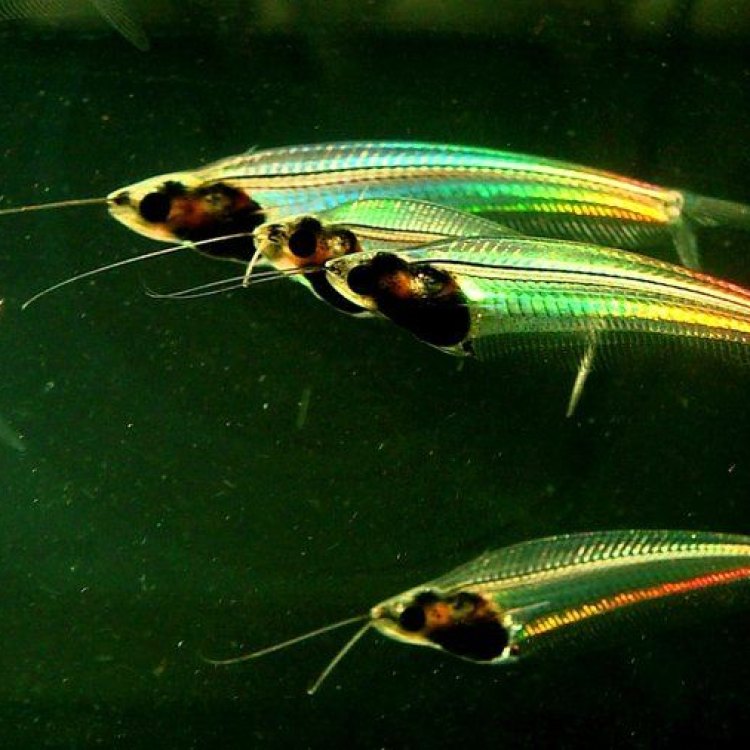
Ghost Catfish
- Adult Size: 2 to 3 inches
- Average Lifespan: 5 to 8 years
- Reproduction: Eggs
- Reproductive Behavior: Males guard the eggs until they hatch
- Sound or Call: None
- Migration Pattern: Unknown
- Social Groups: Often kept in groups in captivity
- Behavior: Nocturnal and shy
- Threats: Habitat destruction and water pollution
- Conservation Status: Data Deficient
- Impact on Ecosystem: They are important scavengers in freshwater ecosystems
- Human Use: Popular ornamental fish
- Distinctive Features: Translucent body and long whiskers
- Interesting Facts: They have specialized chemoreceptors on their body that allow them to detect prey in complete darkness
- Predator: Large fish and birds
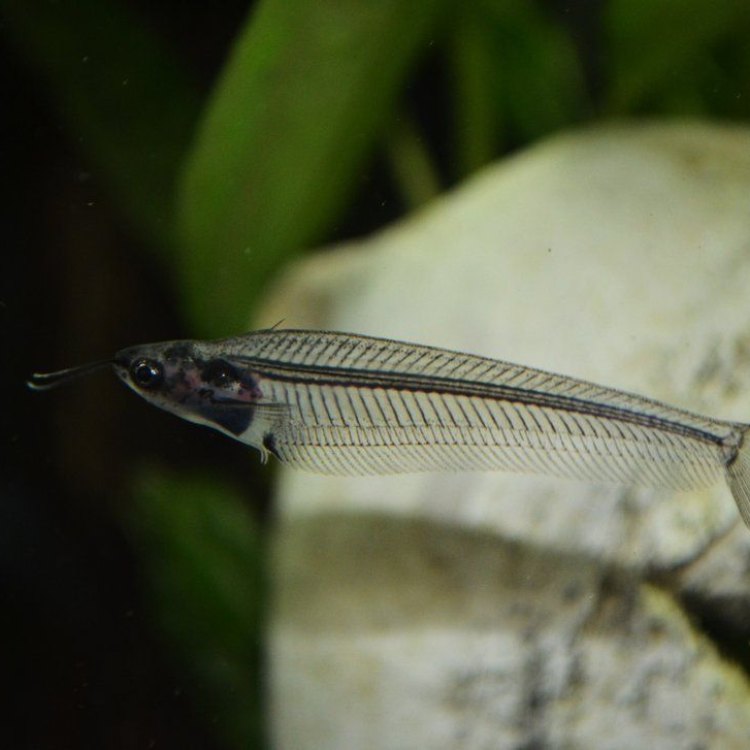
Kryptopterus vitreolus
The Enigmatic Ghost Catfish: A Hidden Treasure of Freshwater Ecosystems
Hidden in the depths of freshwater rivers and streams, there is a mysterious creature that few have seen and even fewer understand. The Ghost Catfish, scientifically known as Kryptopterus bicirrhis, is a species of catfish that has captured the fascination of fish enthusiasts and researchers alike. Its elusive nature, unique physical features, and important role in freshwater ecosystems make it a fascinating subject of study.Adult Ghost Catfish are relatively small, typically reaching a size of only 2 to 3 inches PeaceOfAnimals.Com. They have a slender and translucent body, giving them an almost ghost-like appearance. This is where their common name "Ghost Catfish" stems from, and it perfectly captures their elusive and mysterious nature.
These small fish have an average lifespan of 5 to 8 years, making them a long-term commitment for fish keepers. In the wild, they are found in freshwater habitats such as rivers, streams, and flooded forests in Southeast Asia. However, despite their captivating appearance, very little is known about their natural behavior and life cycle due to their nocturnal and elusive nature.
Reproduction in Ghost Catfish occurs through egg-laying, with females often producing large batches of eggs that are guarded by the males. The males attach the eggs to submerged surfaces, such as rocks or plants, and diligently protect them until they hatch. This behavior is not commonly observed in fish and adds to the uniqueness of this species.
One distinctive aspect of Ghost Catfish is their lack of sound or call Great Dane Mix. While many fish species use sound to communicate and attract mates, these elusive creatures prefer to keep to themselves and remain silent. As such, their migration patterns are still unknown, and little is known about their social behavior within their natural habitat.
However, in captivity, Ghost Catfish are often kept in small groups, proving that they may have some social tendencies. Fish enthusiasts have also noted that these fish are nocturnal and shy, often hiding during the day and becoming active at night. This behavior is another reason why they are often considered a hidden treasure of freshwater ecosystems.
Despite their elusive nature, Ghost Catfish have become increasingly popular as ornamental fish. Their unique appearance, calm demeanor, and small size make them an ideal addition to freshwater aquariums. However, their popularity in the pet trade has also led to their decline in the wild, as they are often harvested for the aquarium trade.
Sadly, the Ghost Catfish faces many threats in its natural habitat, making its conservation status "Data Deficient" according to the IUCN Red List. Habitat destruction and water pollution are the primary threats to their survival. The destruction of freshwater ecosystems, such as rivers and streams, has led to a decline in their population, as they rely on these habitats for survival.
As scavengers, Ghost Catfish play an essential role in freshwater ecosystems by feeding on decaying matter and keeping the water clean. However, with their declining population, there is a risk of disrupting the delicate balance of these ecosystems. Their importance in maintaining the health of freshwater habitats further emphasizes the need for their conservation.
Beyond their environmental significance, Ghost Catfish also have some interesting and distinct features that set them apart from other fish species. One of the most intriguing features of the Ghost Catfish is their long whiskers, also known as barbels. These barbels have specialized chemoreceptors, allowing the fish to detect prey in complete darkness. This adaptation is essential in their nocturnal lifestyle and highlights their ability to thrive in their natural habitat.
Like many other fish species, Ghost Catfish also have predators, with larger fish and birds being their main threats. However, their translucent body acts as a form of camouflage, making it harder for predators to spot them. This, in combination with their nocturnal behavior, allows them to stay hidden and avoid becoming a meal for larger predatory fish.
In many ways, Ghost Catfish are an enigma, with many aspects of their life and behavior still a mystery. However, they have become a popular aquarium fish, providing fish enthusiasts with an opportunity to observe and learn more about this fascinating species. Through proper research and conservation efforts, we may be able to uncover more about these elusive creatures and protect them from further decline.
In conclusion, the Ghost Catfish is an important and intriguing species that deserves our attention and protection. Their translucent bodies, long whiskers, and unique reproductive behavior make them a unique fish species in the world of freshwater ecosystems. However, their decline in the wild due to various threats highlights the urgent need for conservation efforts to ensure their survival in their natural habitat. As we continue to uncover more about this elusive and mysterious species, let us also strive to protect and preserve their place in our freshwater ecosystems.
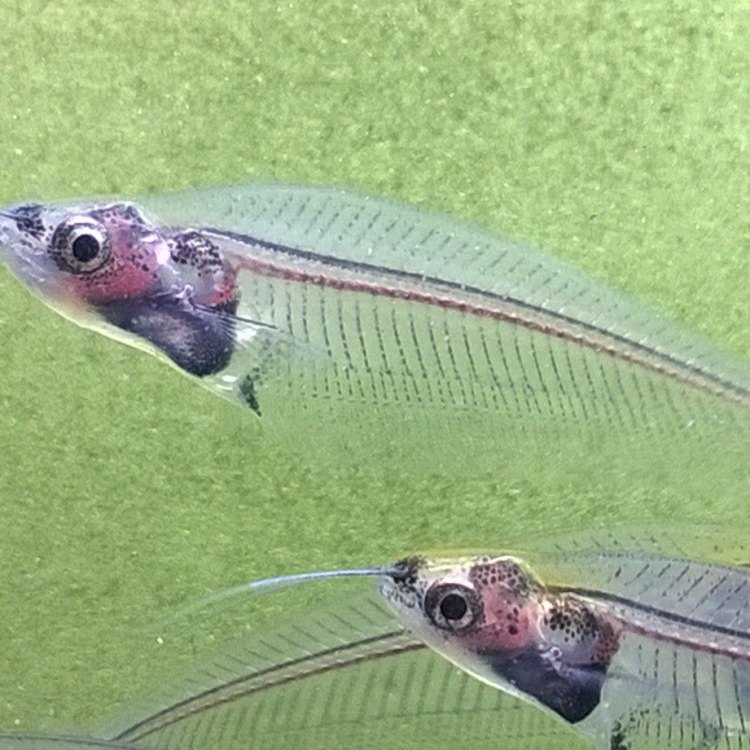
The Mystical Ghost Catfish: A Closer Look at the Invisible Creature
Disclaimer: The content provided is for informational purposes only. We cannot guarantee the accuracy of the information on this page 100%. All information provided here may change without prior notice.


